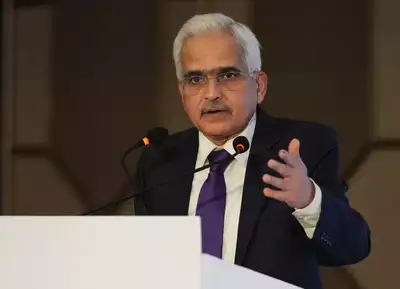Reserve Bank of India governor Shaktikanta Das
India’s new
monetary policy committee
may lay the ground for an
interest rate cut
on Wednesday as a wave of global easing kicks off and growth in the world’s fastest-expanding major economy moderates.
While most of the 35 economists in a Bloomberg survey expect the Reserve Bank of India’s six-member
MPC
to keep the repurchase rate unchanged at 6.5%, several predict a switch to a ‘neutral’ stance for the first time since June 2019 from its current hawkish view.
The meeting is the first under a new policy committee following the appointment last week of three external members, well-known economists with academic and finance backgrounds.
Governor Shaktikanta Das has so far dismissed calls for rate cuts, concerned that high food prices will prevent inflation from staying at the 4% target level on a sustainable basis. However, with the US Federal Reserve now pivoting and other central banks following with rate cuts, pressure is building on the RBI to do the same, especially after good rainfall and predictions of a bumper harvest.
A change in the RBI’s policy stance language would pave the way for a quarter-point rate cut in December, according to economists at HSBC Plc.
“We believe the RBI doesn’t gain from waiting any longer,” Pranjul Bhandari and Aayushi Chaudhary wrote in a note. They expect another quarter-point reduction at the February meeting, taking the repurchase rate to 6%.
Here are some of the key issues to watch out for in the policy statement at 10 am:
Three new external members joined the MPC, although only one of them — Saugata Bhattacharya, a former chief economist at Axis Bank Ltd — has publicly voiced his views on inflation and growth recently, advocating recently for the RBI to cut rates.
However, economists said it’s unlikely the new members will vote against the three other RBI officials on the MPC so early on.
They “may agree with RBI’s house view for some time,” said Rahul Bajoria, an economist at Bank of America Corp. “Still, incoming near-term data is much more mixed, and growth risks appear tilted to the downside,” he said, predicting a shift in policy stance.
In the past two MPC meetings, external members Ashima Goyal and Jayanth Varma voted for rate cuts stating, arguing that the RBI’s insistence on keeping rates high was damaging growth.
There is agreement that the Reserve Bank of India needs to pivot from its hawkish hold to policy easing. Consensus is expecting the first cut in December. We think it will happen at the Oct. 9 review. The three new external members on the monetary policy committee, along with the RBI members, are likely to focus on the latest developments — a jumbo Federal Reserve rate cut and hostilities in the Middle East that heighten supply-chain risks.
Abhishek Gupta, India economist
— Abhishek Gupta, India economist
Inflation rhetoric may be toned down
The RBI will likely stick to its fiscal year growth and inflation forecasts of 7.2% and 4.5%, respectively, although there’s a chance the quarterly CPI forecasts could be adjusted, particularly for the July-September period, said Kaushik Das, an economist at Deutsche Bank AG.
The central bank had projected 4.4% inflation for the period, but the actual reading could turn out to be lower, in the range of 4-4.1%, he said.
India had its best monsoon rains, which irrigate about half of the country’s farmland, since 2020, setting the stage for a bumper harvest of crops such as rice, and boosting economic prospects for rural areas.
Since the last rate decision, official data showed economic growth moderated to 6.7% in the April-June quarter, below the central bank’s projection of 7.1%, while signs are growing of a softening in urban consumption.
Bond markets could rally
Any signs of dovishness from the central bank, such as a tweak in the policy stance language, could propel a bond rally. Traders are also watching any possible changes that could indicate easier liquidity conditions in the banking system. Yields have eased around 40 basis points from the year’s peak of 7.25% on hopes of RBI easing.
“The next move from the RBI will be a rate cut,” said Nathan Sribalasundaram, a rates strategist at Nomura Holdings Inc in Singapore. “Favorable demand-supply, banks’ investment requirements and foreign investor demand will push yields lower.”


